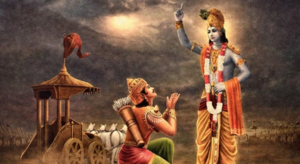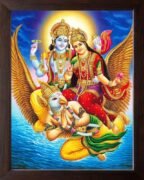By: C.S. Dinesh

A devotee had mailed Sai Maharaj a copy of Tilak’s book in Marathi ‘Gita Rahasya’ (Secret of the Gita). Baba reverentially kept the book on his head and while giving it to Nana Saheb Nimonkar enlisted three qualities – Honesty, Humility, and Faith in oneself – as cardinal points to be eligible to receive its grace.
The Bhagavad Gita is the golden path that presents to its readers a variety of yogic systems that enable them to experience the Ultimate Beatitude. The conspicuous feature of this path is that it attaches equal importance to both the spiritual and worldly aspects of life. Seekers often complain that as soon as they sit to meditate, all sorts of turbulent thoughts begin to rush into their minds, causing untold distraction. This happens because of the deep-rooted tendency of the mind to move in the pleasure garden of the senses. Sai Baba clearly explains that ‘Chitta’ is the mind-stuff, and the ‘Vrittis’ are the waves and ripples rising within it. These Vrittis are our universe comprising myriad objects.
We cannot see the bottom of the lake because its surface is filled with waves. One can glimpse at the bottom when the waves have subsided, and the water is calm. The bottom of the lake, thus, is our true Self; the lake is the Chitta, and the waves, the Vrittis.
the bottom when the waves have subsided, and the water is calm. The bottom of the lake, thus, is our true Self; the lake is the Chitta, and the waves, the Vrittis.
In Chapter VI of the Gita, which elaborates on Dhyan Yoga, Krishna enlightens us on how a seeker endeavors to disconnect the mind from sensual pleasures and shift its focus inwards, making it calm and serene. Sri Narasimha Swamiji explains that the “human mind is turned outwards. Yoga attempts to explore the inner world. We must divest our minds of all sensual desires, abstract our attention from all external objects, and absorb it in the object of meditation,” in Gita 6:10. In his Discourse, Krishna lays down the golden principles for meditation. He recommends using an asana made from Kusha grass – a bad conductor of electricity. This helps conserve the powerful spiritual currents generated within the body during meditation; Gita 6:11.
Secondly, while practicing meditation, the seeker should firmly hold his body, head, and neck erect and still without looking around. This helps the smooth flow of the life current from the sensory nerve branches through the spine; Gita 6:13. Thirdly, Krishna asserts that the seeker should exercise utmost moderation in his eating and sleeping habits. Yoga, he says, is not possible for that yogi who eats a lot, nor for him who does not eat at all, nor for him who sleeps too much nor for him who is constantly awake; Gita 6:16. Rajasic food items like meat, eggs, pickles should be strictly avoided as these give rise to carnal cravings.
 preserved his vital force by the vow of celibacy and sublimated it into Ojas, conversion of sexual energy into spiritual energy, can practice steady meditation for an extended period without distraction. Without continence, it is impossible to attain success in yoga; Gita 6:14.
preserved his vital force by the vow of celibacy and sublimated it into Ojas, conversion of sexual energy into spiritual energy, can practice steady meditation for an extended period without distraction. Without continence, it is impossible to attain success in yoga; Gita 6:14.

Leave a Reply